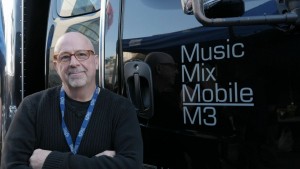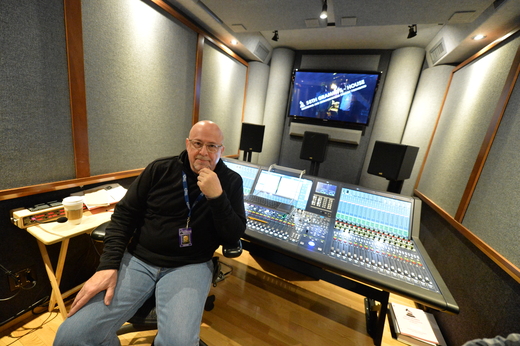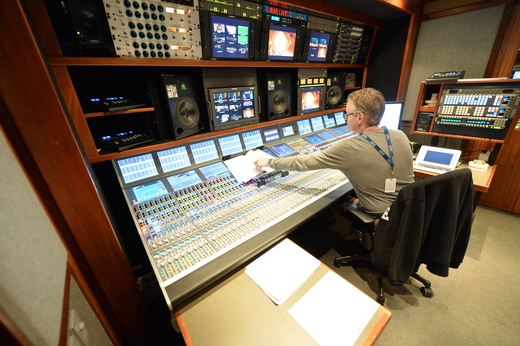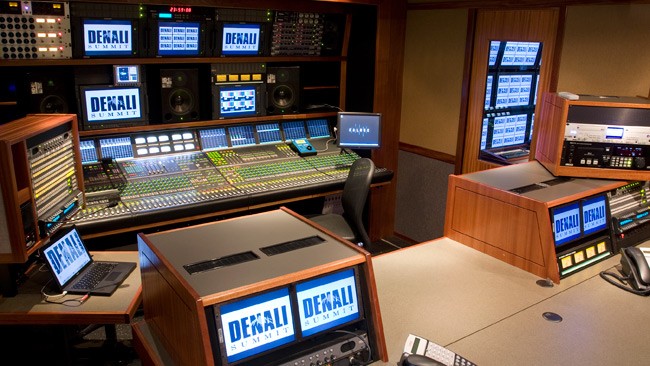Behind the Scenes at the 58th GRAMMY Awards: A Tech Tour of “Music’s Biggest Night”
If you ever have the good fortune to be a nominee or a performer at the GRAMMY Awards, chances are it will stand as one of the biggest nights of your career.
With over eighteen thousand in attendance at Los Angeles’ Staples Center (plus nearly thirty million peering in from home) music awards simply do not get bigger than this, and it’s a safe assumption that anyone who steps foot on that stage will be bringing their A-game.
But the behemoth 200 foot stage is not the only place where the people involved in the production plan to take their A-game: For the producers, mixers, engineers, camera operators, and everyone else working behind the scenes, the GRAMMY ceremony is just as much a career touchstone as it is for the artists themselves.
As the world’s largest-scale celebration of music, it’s only fitting that the best in the business are called upon to execute this flagship production which, year after year, stakes its claim as the cutting edge in broadcast and live sound.
With more than fourteen acts and twenty stage setups performing a total of forty songs over the course of a 3.5-hour international telecast, it is truly a massive undertaking. In addition to the small army of producers, mixers and engineers on site (and the 128 stage and crew members who work tirelessly around the clock for weeks prior) the audio team enlists engineers to perform real-time quality control checks of the sonics in various regions throughout the country.
I started my behind-the-scenes tour of the GRAMMYs at the top of a loading ramp behind the Staples Center on day one of rehearsals, T-minus 3 days to show, where two mobile recording trucks were parked side by side. These all-black trucks are property of Music Mix Mobile (M3), and are the first stop in the signal path after it is split off from the stage.
From here, the signal is sent downstairs to the Denali Summit Broadcast production truck where the 5.1 music mix is married to the other audio elements including playback bumpers, walk on/walk off music, ambient crowd audio, and eventually, the video feed.
The two M3 trucks are outfitted identically with brand new Lawo mc²56 consoles (a change from last year’s Avid D-Commands), with Truck A serving primarily as a sort of “tracking” studio for the rehearsals, and Truck B serving as a more of a “mix” and playback studio where artists can evaluate their performances.
During GRAMMY rehearsals, each act has ninety minutes to run three or four passes of their performance. The stage is split into two halves (Stage A and Stage B), one of which is in use while the other is being prepped for the next artist. In addition a “Dish” stage extends out into the audience.
The acts are held to a very tight schedule and are in constant rotation during rehearsals. After a performer finishes their final pass, the files recorded in the M3’s Truck A, named “Eclipse” are transferred via fiber optic cable to Truck B, called “Horizon”, where the artists and their engineers have the next ninety minutes to refine the mix. This process repeats each day of rehearsals, so even with such a packed schedule, the artists and their engineers still have ample time to dial in their sound.
The next stop for the signal after the M3 trucks are the Denali Summit broadcast trailers, located at the bottom of the loading ramp where my journey began. With almost two hundred feet in combined length, packed to the hilt with world-class audio and video broadcast equipment (including a Calrec Apollo console), the sheer magnitude of the setup in the Denali Summit broadcast trailers alone is mind-bending.
What it takes to secure redundancy in case of failure across a system this huge is considerable. Almost everything has a duplicate path, with the total length of cabling in this set of trucks alone exceeding several dozens of miles, It’s inside these two powerhouse control centers that all of the video control, video routing, audio routing, and switching between the 18 cameras is done.
This is also where veteran broadcast mixer Tom Holmes marries the 5.1 mixes from the M3 trucks (showing up on a single VCA fader) to the video signal. The final stop from here is back up the ramp, and out to the satellite uplink truck, which sends directly to CBS.
As to be expected with a production of this magnitude, there is an all-star cast of engineers and mixers waiting to work their magic on the incoming sounds (and sights) at every stop along the signal path.
Mix engineer Ron Reaves has been holding down Front-of-House duties for the GRAMMYs since the early 2000’s, with Leslie Ann Jones of Skywalker Sound always by his side, serving as a trusted consultant and confidant.

John Harris at the M3 truck. Click to see a video interview with Soundmatters.
Emmy Award-winning engineers Eric Schilling and John Harris are two of the heaviest hitters in broadcast mixing, splitting the M3 truck duties 50/50 between them.
Meanwhile, Dave Bellamy of Soundtronics holds down the fort on the massive 300+ channel wireless setup, and audio coordinator Michael Abbott is going on 20+ years keeping all the details straight for the big show.
Despite the daunting logistical scale for a show this size, there was a palpable sense of calm-and-collected energy common to all of the audio and video personnel I came into contact with throughout the day.
In a brief exchange with Glenn Lorbecki, a prominent member of the Producer & Engineers wing, who manages the traffic between all of the audio engineers working the show, he said, “Part of the deal is that everyone here is the best in the business. Everyone has done this show before—a bunch of times —and they all know the drill.
“It makes it a lot easier when you can look to the side of you and see a guy who you’ve seen for ten years who gets it right every time. That makes it a lot easier. We’re trying to celebrate the best in the world. That’s why we marshall all of these resources.”
Having peered behind the curtain, it’s easy to focus your attention on how a production of this scale has been dialed in so faultlessly from a technical angle. But the techs behind the scenes were quick to remind me of why it is all happening in the first place: The Music.
The GRAMMYs continue to lead the way in celebrating the music makers and those who make it all possible, and it is humbling for those who dedicate their lives to audio to step back and remember that without the music there would simply be no job to do. I will certainly be enjoying the GRAMMY award shows with a new set of eyes—and ears—this year.
Tune in tonight, February 15th, 2016 at 8pm EST to check out the 58th annual Grammy Awards.
Please note: When you buy products through links on this page, we may earn an affiliate commission.











Orrin Charm
February 16, 2016 at 8:08 pm (9 years ago)So with all that backstage talent, how did the entire show go so horribly and painfully wrong? The audio kept dropping in volume in the middle of many songs, the vocals were often inaudible (bad choice of microphones maybe?), the 5.1 mix had no dimension at all (except during the commercials, so I knew my playback was fine), and cuts between acts were harsh and abrupt?
I really expected much higher quality standards from CBS and the Grammys!!
Also, someone should shoot the LD! Those blinders were effectively an assault on the audience, and certainly were not working for video!
For the most part, I couldn’t see or hear much of the show.
Joebob Morespl
February 17, 2016 at 12:20 am (9 years ago)I posted this on my page about the Hollywood Vampires segment.
“I was so looking forward to this tribute to Lemmy, It looked like a great show…..too bad the LD and Video director thought the performance was all about them and not the band. The LD spends more time lighting (blinding) the audience and cameras then lighting the band and the video director has to prove what a virile man he is by calling 100 cuts a minute. That really blew chunks.”